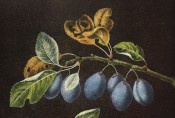Prunus domestica ‘Damson’
Generally considered a Prunus domestica L. cultivar but see notes below. ‘Damson, Common Damson, Round Damson. Fruit very small, roundish-ovate. Skin deep dark purple or black, covered with thin bloom. Flesh greenish-yellow, juicy very acid, and rather austere till highly ripened, and separating from the stone. Shoots downy. A well-known preserving plum. Ripe in the end of September.’ [Hogg – Fruit Manual p.236/1860]. The Damson is often placed in a separate species, Prunus insititia L., or separated as a subspecies, insititia, of Prunus domestica L. Damson varieties were in the past usually raised from stones.
Horticultural & Botanical History
‘The origin of the Damsons […] was in Syria and near the ancient city, Damascus, their written history dating back several centuries before Christ. This plum has escaped from cultivation in nearly all the temperate parts of Europe and more or less in the eastern United States, the wild forms often passing under other names, as the Wild, Wheat, Spilling, Donkey, Ass, Hog and Horse plums. The true Damsons have a fine spicy taste, which makes them especially desirable for cooking and preserving, but a very decided astringency of the skin makes most of the varieties of Damsons undesirable to eat out of the hand; this astringency largely disappears with cooking or after a light frost.’ [Plums of New York p.39].
‘The Damson takes its name from Damascus from whence it was brought into Italy at least a century before the Christian era. What is a Damson? In England and America it is an oval, usually black, Insititia. The European continental countries have an entirely different conception of a Damson from that of the English and Americans. The Germans speak of our common plums as Damson-like, while the French use the term Damas indiscriminately. The English, however, have not always made a sharp distinction for Parkinson in 1629 speaks of the great Damaske or Damson Plummes as sweet prunes imported from France and Gerard in 1636 described the Damson tree as synonymous to the Plum. The term Damson is applied to a group as well as to a variety.’ [Plums of New York p.186].
‘The Damson seems to be a fruit peculiar to England. We do not meet with it abroad, nor is any mention made of it in any of the pomological works or nurserymen's catalogues on the Continent. In America the varieties of Damson are as much cultivated as with us, and that is not to be wondered at; but it is singular that the cultivation of Damsons should be confined to our own race. There are many varieties of this fruit grown in this country, all originating from the native plum, Prunus insititia, from which also the Bullace is derived. The only difference between a Bullace and a Damson is that the former is round and the latter oval.’ [Hogg – Fruit Manual p.695/1884]. Hogg describes six varieties, including a white-skinned fruit.
‘There are several sorts of Damson with black fruit cultivated in England; such as the Common Black, with smooth spiny branches ; Royal Damson, similar to the Prune Damson, but said to be larger; and the Shropshire Damson, with smooth branches, but not spiny. These are much alike in figure, but they differ a little in size, and possess different degrees of merit. This latter quality, however, depends upon the manner in which the tree has been propagated; the soil and situation in which it grows; and the health and vigour of the tree itself. Damsons raised from suckers, and planted in hedge-rows, or grown among nut-bushes, or crowded among and under other trees, can never be expected to produce such fine, thick-fleshed, high-flavoured fruit, as those which are grown upon sound healthy standards, in proper situations, unincumbered with coarse strong-growing trees.’ [George Lindley – Orchard guide p.244/1831]. This excerpt from Lindley is interesting, describing as it does the use of the vigorous and hardy Damson for purposes other than fruit production. In rural England, as late as the 1960s, it was not unusual to see an occasional Damson growing in a mature hedge along with other Rosaceae, particularly Black Thorn (Prunus spinosa L.), known locally in Warwickshire as Sloe.
Figured in Pomona Britannica [PB pl.XXII/1812], the figure used here, and Saint Hilaire [pl.223/1830].
History at Camden Park
Listed in Addenda to the 1857 catalogue as ‘Damson’ [Plum no.17/1857].
Notes
Published May 27, 2010 - 03:31 PM | Last updated Jul 22, 2011 - 10:50 AM
| Family | Rosaceae |
|---|---|
| Category | |
| Region of origin | Garden origin, Syria |
| Synonyms |
|
| Common Name | Culinary Plum, Damson, summer |
| Name in the Camden Park Record |
Damson |
| Confidence level | high |


